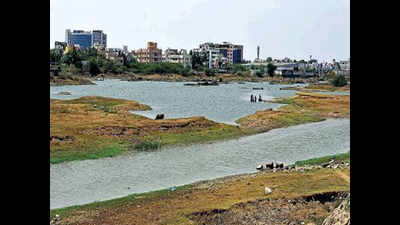- News
- City News
- chennai News
- Restored in time, two lakes in Chennai now brim with water
Trending
This story is from June 13, 2019
Restored in time, two lakes in Chennai now brim with water
Given up for dead a couple of years ago, the Narayanapuram lake in Sunnambu Kolathur on 200 ft Thorappakkam-Pallavaram Radial Road and Puducherry Keni near Sholinganallur today

The Narayanapuram lake in Pallikaranai and Puducherry Keni in Sholinganallur showed improvement in water quality and level after they were cleaned and restored
CHENNAI: Given up for dead a couple of years ago, the Narayanapuram lake in Sunnambu Kolathur on 200 ft Thorappakkam-Pallavaram Radial Road and Puducherry Keni near Sholinganallur today offer a pleasant sight with an impressive sheet of water.
People have been spotted washing and bathing, and even angling in the water bodies. It is all due to eco-restoration undertaken at the water bodies.Once invasive water hyacinth was removed and the inflow of sewage was plugged, the water level in the lakes started recharging the groundwater table in the localities too.
The invasive water hyacinth, if not cleared, spreads like a mat on the surface of a water body, blocking sunlight from penetrating, resulting in depletion of oxygen levels. Slowly the organisms inside are destroyed and the water body itself dies a natural death, said activist Vasantha Raja.
Untreated raw sewage causes contamination and water hyacinth thrives on contaminated water and invades the water body quickly. After the Narayanapuram lake was restored, typha reed which is found in the Pallikaranai marshland, has started growing in a portion of the lake.
The Puducherry Keni near Sholinganallur faced a similar problem. Bio-remediation work helped revive it.
Both the water bodies are now free of water hyacinth and sewage does not enter them. It had taken activists nearly six months to clear the water hyacinth, strengthen the bunds and desilt the two water bodies.
The ecological restoration of these two small water spread areas clearly showed that if water bodies are cleaned and maintained similarly, they can become an alternative source of water in times of drought.
People have been spotted washing and bathing, and even angling in the water bodies. It is all due to eco-restoration undertaken at the water bodies.Once invasive water hyacinth was removed and the inflow of sewage was plugged, the water level in the lakes started recharging the groundwater table in the localities too.
The invasive water hyacinth, if not cleared, spreads like a mat on the surface of a water body, blocking sunlight from penetrating, resulting in depletion of oxygen levels. Slowly the organisms inside are destroyed and the water body itself dies a natural death, said activist Vasantha Raja.
Untreated raw sewage causes contamination and water hyacinth thrives on contaminated water and invades the water body quickly. After the Narayanapuram lake was restored, typha reed which is found in the Pallikaranai marshland, has started growing in a portion of the lake.
This indicates improvement in the ecology of the lake. Moreover, this reed will not allow the reappearance of water hyacinth in the water body.
The Puducherry Keni near Sholinganallur faced a similar problem. Bio-remediation work helped revive it.
Both the water bodies are now free of water hyacinth and sewage does not enter them. It had taken activists nearly six months to clear the water hyacinth, strengthen the bunds and desilt the two water bodies.
The ecological restoration of these two small water spread areas clearly showed that if water bodies are cleaned and maintained similarly, they can become an alternative source of water in times of drought.
End of Article
FOLLOW US ON SOCIAL MEDIA










